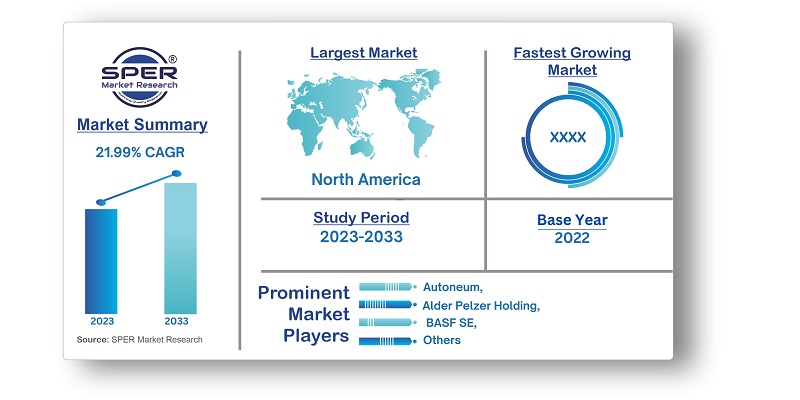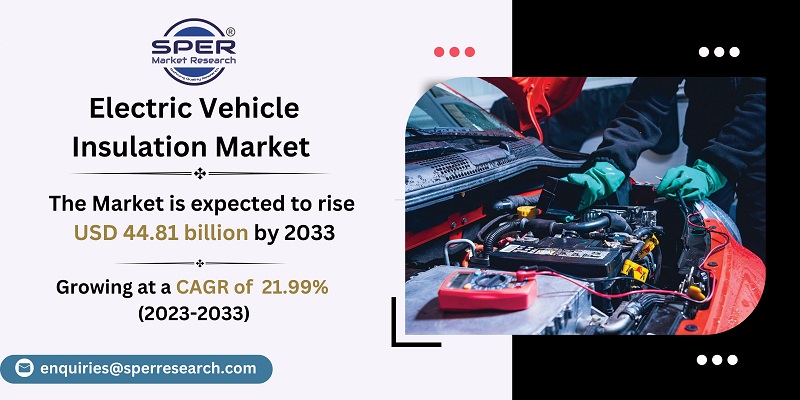
Electric Vehicle Insulation Market Growth, Size, Trends, Revenue, Share, Scope and Future Outlook
Electric Vehicle Insulation Market Size- By Insulation type, By Product type, By Application, By Propulsion type- Regional Outlook, Competitive Strategies and Segment Forecast to 2033
| Published: Nov-2023 | Report ID: AMIN23180 | Pages: 1 - 224 | Formats*: |
| Category : Automotive & Transportation | |||
- 2023: At 'The Battery Show 2023,' Huntsman Corporation announced the development of innovative polyurethane, carbon nanotube, and epoxy materials, all of which are intended to aid in the integration of batteries into electric vehicles while improving their protection and performance.
- 2022: In order to provide the clients in the area with specialized mechanical, thermal, and acoustic insulation and protection systems, Armacell International S.A. opened a new facility in Singapore.


| Report Metric | Details |
| Market size available for years | 2019-2033 |
| Base year considered | 2022 |
| Forecast period | 2023-2033 |
| Segments covered | By Insulation type, By Product type, By Application, By Propulsion type. |
| Regions covered | North America, Asia-Pacific, Latin America, Middle East & Africa and Europe |
| Companies Covered | Autoneum, Alder Pelzer Holding, BASF SE, Dupont, Elmelin ltd., Morgan Advanced Materials, Saint-Gobain, Unifrax, Techman Advanced Materials Engineers. |
- Automotive Manufacturers
- Electric Vehicle Owners and Fleet Managers
- Environmental Organizations
- End-User Industries
- Government and Regulatory Bodies
- Investors and Financial Institutions
- Industry Associations and Forums
- Suppliers and Distributors
- Others
| By Insulation type: |
|
| By Product type: |
|
| By Application: |
|
| By Prolusion type: |
|
- Global Electric Vehicle Insulation Market Size (FY’2023-FY’2033)
- Overview of Global Electric Vehicle Insulation Market
- Segmentation of Global Electric Vehicle Insulation Market By Insulation type (Acoustic, Electrical, Thermal)
- Segmentation of Global Electric Vehicle Insulation Market By Product type (Ceramic, Foamed plastics, Thermal Interface Materials)
- Segmentation of Global Electric Vehicle Insulation Market By Application (Battery pack, Interiors, Under the Bonnet )
- Segmentation of Global Electric Vehicle Insulation Market By Prolusion type (Battery Electric Vehicle (BEV),Fuel Cell Electric Vehicle (FCEV),Hybrid Electric Vehicle (HEV),Plug-in Hybrid Electric Vehicle)
- Statistical Snap of Global Electric Vehicle Insulation Market
- Expansion Analysis of Global Electric Vehicle Insulation Market
- Problems and Obstacles in Global Electric Vehicle Insulation Market
- Competitive Landscape in the Global Electric Vehicle Insulation Market
- Impact of COVID-19 and Demonetization on Global Electric Vehicle Insulation Market
- Details on Current Investment in Global Electric Vehicle Insulation Market
- Competitive Analysis of Global Electric Vehicle Insulation Market
- Prominent Players in the Global Electric Vehicle Insulation Market
- SWOT Analysis of Global Electric Vehicle Insulation Market
- Global Electric Vehicle Insulation Market Future Outlook and Projections (FY’2023-FY’2033)
- Recommendations from Analyst
1.1. Scope of the report1.2. Market segment analysis
2.1. Research data source2.1.1. Secondary Data2.1.2. Primary Data2.1.3. SPER’s internal database2.1.4. Premium insight from KOL’s
2.2. Market size estimation
2.2.1. Top-down and Bottom-up approach
2.3. Data triangulation
4.1. Driver, Restraint, Opportunity and Challenges analysis4.1.1. Drivers4.1.2. Restraints4.1.3. Opportunities4.1.4. Challenges
4.2. COVID-19 Impacts of the Global Electric Vehicle Insulation Market
5.1. SWOT Analysis
5.1.1. Strengths5.1.2. Weaknesses5.1.3. Opportunities5.1.4. Threats
5.2. PESTEL Analysis
5.2.1. Political Landscape5.2.2. Economic Landscape5.2.3. Social Landscape5.2.4. Technological Landscape5.2.5. Environmental Landscape5.2.6. Legal Landscape
5.3. PORTER’s Five Forces
5.3.1. Bargaining power of suppliers5.3.2. Bargaining power of buyers5.3.3. Threat of Substitute5.3.4. Threat of new entrant5.3.5. Competitive rivalry
5.4. Heat Map Analysis
6.1. Global Electric Vehicle Insulation Market Manufacturing Base Distribution, Sales Area, Product Type6.2. Mergers & Acquisitions, Partnerships, Product Launch, and Collaboration in Global Electric Vehicle Insulation Market
7.1. Global Electric Vehicle Insulation Market Value Share and Forecast, By Insulation Type, 2023-20337.2. Acoustic7.3. Electrical7.4. Thermal
8.2. Ceramic8.1. Global Electric Vehicle Insulation Market Value Share and Forecast, By Product Type, 2023-20338.3. Foamed Plastic8.4. Thermal Interface Material
9.1. Global Electric Vehicle Insulation Market Value Share and Forecast, By Application, 2023-20339.2. Battery pack9.3. Interiors9.4. Under the Bonnet
10.1. Global Electric Vehicle Insulation Market Value Share and Forecast, By Prolusion Type, 2023-203310.2. Battery Electric Vehicle (BEV)10.3. Fuel Cell Electric Vehicle (FCEV)10.4. Hybrid Electric Vehicle (HEV)10.5. Plug- in Hybrid Electric Vehicle
11.1. Global Electric Vehicle Insulation Market Size and Market Share
12.1. Global Electric Vehicle Insulation Market Size and Market Share By Insulation Type (2019-2026)12.2. Global Electric Vehicle Insulation Market Size and Market Share By Insulation Type (2027-2033)
13.1. Global Electric Vehicle Insulation Market Size and Market Share By Product Type (2019-2026)13.2. Global Electric Vehicle Insulation Market Size and Market Share By Product Type (2027-2033)
14.1. Global Electric Vehicle Insulation Market Size and Market Share By Application (2019-2026)14.2. Global Electric Vehicle Insulation Market Size and Market Share By Application (2027-2033)
15.1. Global Electric Vehicle Insulation Market Size and Market Share By Propulsion type (2019-2026)15.2. Global Electric Vehicle Insulation Market Size and Market Share By Propulsion type (2027-2033)
16.1. Global Electric Vehicle Insulation Market Size and Market Share By Region (2019-2026)16.2. Global Electric Vehicle Insulation Market Size and Market Share By Region (2027-2033)
16.3. Asia-Pacific
16.3.1. Australia16.3.2. China16.3.3. India16.3.4. Japan16.3.5. South Korea16.3.6. Rest of Asia-Pacific
16.4. Europe
16.4.1. France16.4.2. Germany16.4.3. Italy16.4.4. Spain16.4.5. United Kingdom16.4.6. Rest of Europe
16.5. Middle East and Africa
16.5.1. Kingdom of Saudi Arabia16.5.2. United Arab Emirates16.5.3. Rest of Middle East & Africa
16.6. North America
16.6.1. Canada16.6.2. Mexico16.6.3. United States
16.7. Latin America
16.7.1. Argentina16.7.2. Brazil16.7.3. Rest of Latin America
17.1. Autoneum
17.1.1. Company details17.1.2. Financial outlook17.1.3. Product summary17.1.4. Recent developments
17.2. Alder Pelzer Holding
17.2.1. Company details17.2.2. Financial outlook17.2.3. Product summary17.2.4. Recent developments
17.3. BASF SE
17.3.1. Company details17.3.2. Financial outlook17.3.3. Product summary17.3.4. Recent developments
17.4. Dupont
17.4.1. Company details17.4.2. Financial outlook17.4.3. Product summary17.4.4. Recent developments
17.5. Elmelin Ltd.
17.5.1. Company details17.5.2. Financial outlook17.5.3. Product summary17.5.4. Recent developments
17.6. Morgan Advanced Materials
17.6.1. Company details17.6.2. Financial outlook17.6.3. Product summary17.6.4. Recent developments
17.7. Saint- Gobain
17.7.1. Company details17.7.2. Financial outlook17.7.3. Product summary17.7.4. Recent developments
17.8. Unifrax
17.8.1. Company details17.8.2. Financial outlook17.8.3. Product summary17.8.4. Recent developments
17.9. Zotefoams plc.
17.9.1. Company details17.9.2. Financial outlook17.9.3. Product summary17.9.4. Recent developments
17.10. Relax Sacks
17.10.1. Company details17.10.2. Financial outlook17.10.3. Product summary17.10.4. Recent developments
17.11. Others
SPER Market Research’s methodology uses great emphasis on primary research to ensure that the market intelligence insights are up to date, reliable and accurate. Primary interviews are done with players involved in each phase of a supply chain to analyze the market forecasting. The secondary research method is used to help you fully understand how the future markets and the spending patterns look likes.
The report is based on in-depth qualitative and quantitative analysis of the Product Market. The quantitative analysis involves the application of various projection and sampling techniques. The qualitative analysis involves primary interviews, surveys, and vendor briefings. The data gathered as a result of these processes are validated through experts opinion. Our research methodology entails an ideal mixture of primary and secondary initiatives.



Frequently Asked Questions About This Report
PLACE AN ORDER
Year End Discount
Sample Report
Pre-Purchase Inquiry
NEED CUSTOMIZATION?
Request CustomizationCALL OR EMAIL US
100% Secure Payment






Related Reports
Our Global Clients
Our data-driven insights have influenced the strategy of 200+ reputed companies across the globe.




















